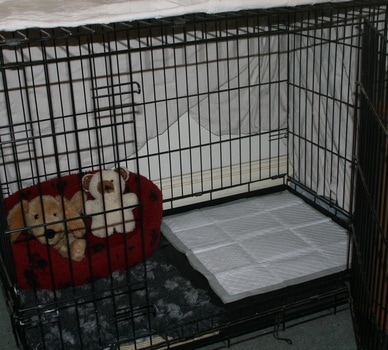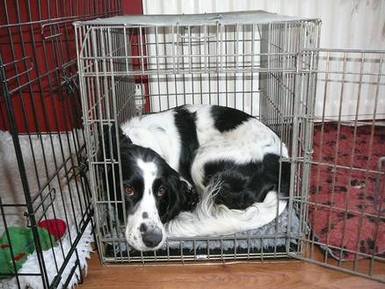USING A CRATE

One of the things many people worry about is whether to have their dog use a crate, and if it is cruel or unkind to put their pooch in one. Hopefully this information will set some minds at ease, because if introduced to it properly your dog can see their crate as their den area, a place of sanctuary and comfort. It is only a brief guide and the time it takes a dog to get used to the crate will vary from dog to dog
Why use a crate?
Which crate?
When choosing a crate, look for one that will allow your dog to lie stretched our fully, turn round and so on. To start with a 3ft crate will probably be fine and will last your dog into adulthood too.
There are many types of crate - fabric, wire, or airline types. For puppies or older dogs not used to crates the wire or airline types are best, the fabric ones can be chewed or ripped but may be great for an older settled dog.
Setting up your crate
Make the crate comfy for your dog. There are some things you may want to use in this doggy den to make it comfy for your pet. You can put in a proper dog bed or just some vetbed, fleecy blankets and a t shirt of yours so there is a familiar smell. Some breeders give a blanket that has the smell of your pups Mum and littermates on it, so use this if you have it.
Crates often have a hard base which makes it easy to clean if your pup has a toileting accident but it is also a good idea to cover this with either a puppy pad or some newspaper to make cleaning up easier.
Some additional items can make this den more cosy for your puppy. Something like a warm hot water bottle or a SnugglePet (a soft toy which makes a heartbeat sound) can be comforting for your pup to snuggle up with.
Finally, putting a blanket over the back and sides of the crate help your dog relax and settle in his doggy den.
Introducing your dog to the crate
Why use a crate?
- Your dog will have his own area to rest in and go to for some peace from the usual household bustle.
- Lets your dog have a lovely, comfortable den area.
- It can be used to encourage toilet training.
- It can keep your dog safe when unsupervised, which can be very useful when you have an inquisitive puppy.
- Helps the dog get used to being in a crate in the car when travelling etc.
Which crate?
When choosing a crate, look for one that will allow your dog to lie stretched our fully, turn round and so on. To start with a 3ft crate will probably be fine and will last your dog into adulthood too.
There are many types of crate - fabric, wire, or airline types. For puppies or older dogs not used to crates the wire or airline types are best, the fabric ones can be chewed or ripped but may be great for an older settled dog.
Setting up your crate
Make the crate comfy for your dog. There are some things you may want to use in this doggy den to make it comfy for your pet. You can put in a proper dog bed or just some vetbed, fleecy blankets and a t shirt of yours so there is a familiar smell. Some breeders give a blanket that has the smell of your pups Mum and littermates on it, so use this if you have it.
Crates often have a hard base which makes it easy to clean if your pup has a toileting accident but it is also a good idea to cover this with either a puppy pad or some newspaper to make cleaning up easier.
Some additional items can make this den more cosy for your puppy. Something like a warm hot water bottle or a SnugglePet (a soft toy which makes a heartbeat sound) can be comforting for your pup to snuggle up with.
Finally, putting a blanket over the back and sides of the crate help your dog relax and settle in his doggy den.
Introducing your dog to the crate
- Be prepared to take your time with this, do not force your puppy into the crate or shut it in the crate before it is completely at ease with it.
- Set the crate up in a quiet area of a room you will be in all the time, do not introduce your pup to its crate where it will be left on his own.
- Leave the door of the crate open, and throw some really tasty treats inside - things like little bits of cooked chicken, sausage etc.
- Let your dog go in and out of the crate searching for the treats and each time it does, give lots of praise. Replenish the treats as needed.
- When your dog seems comfortable with that, put in a tasty chew or a Kong filled with goodies which will take some time to work through. This will encourage your pup to stay in the crate for a longer period and settle to chew.
- At this stage you can start to close the door of the crate for short periods, gradually building up the time your dog is inside the crate with the door shut. You can introduce a command word/s to so he associates that to being in his crate.
- Dont forget to always give praise and reassurance.
- Once your dog is used to the door being shut, you can then start to move out of site of your pup - initially just do that for a few seconds, then return and give praise but gradually increase the time you are out of sight.
- Never leave your dog alone long enough to become distressed. The idea of training is to build up its confidence so it feels safe and comfortable with the idea you will return. Do short bursts, but as often as you can during the day, and build it up slowly.

One important thing to remember is make sure your crate is a good size for your dog!
No, don't worry, this isn't Ginny's crate, she is checking out a puppy one for comfort!!
The amount of time it takes each dog to get used to its crate will vary but usually, with patience, most dogs come to see their crate as a really great place to go to relax and rest.
No, don't worry, this isn't Ginny's crate, she is checking out a puppy one for comfort!!
The amount of time it takes each dog to get used to its crate will vary but usually, with patience, most dogs come to see their crate as a really great place to go to relax and rest.
|
|
|

